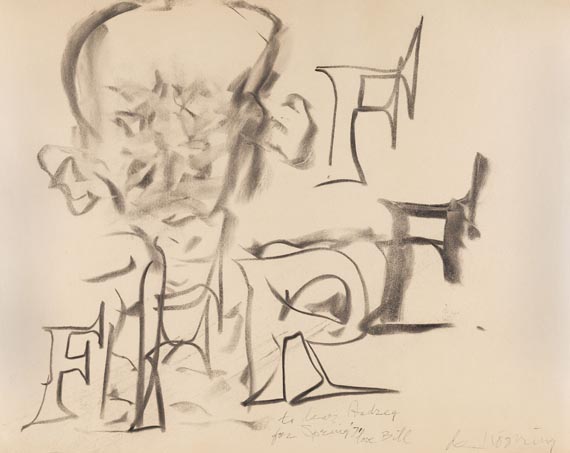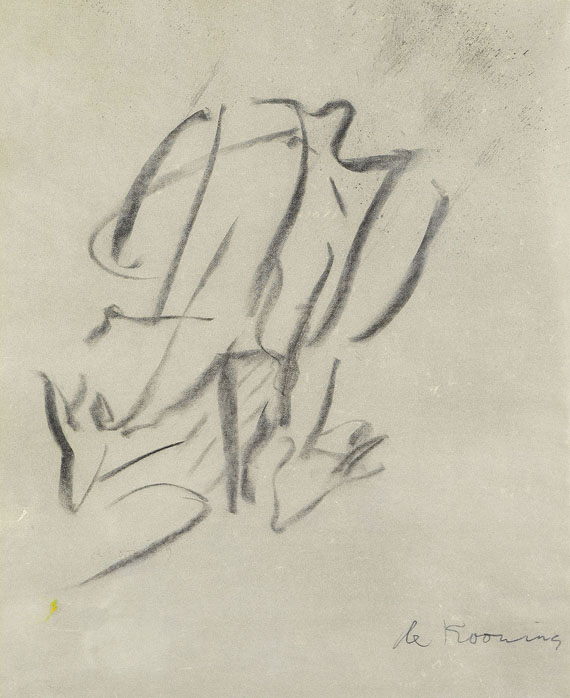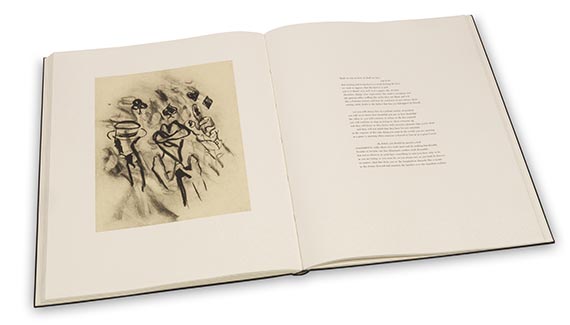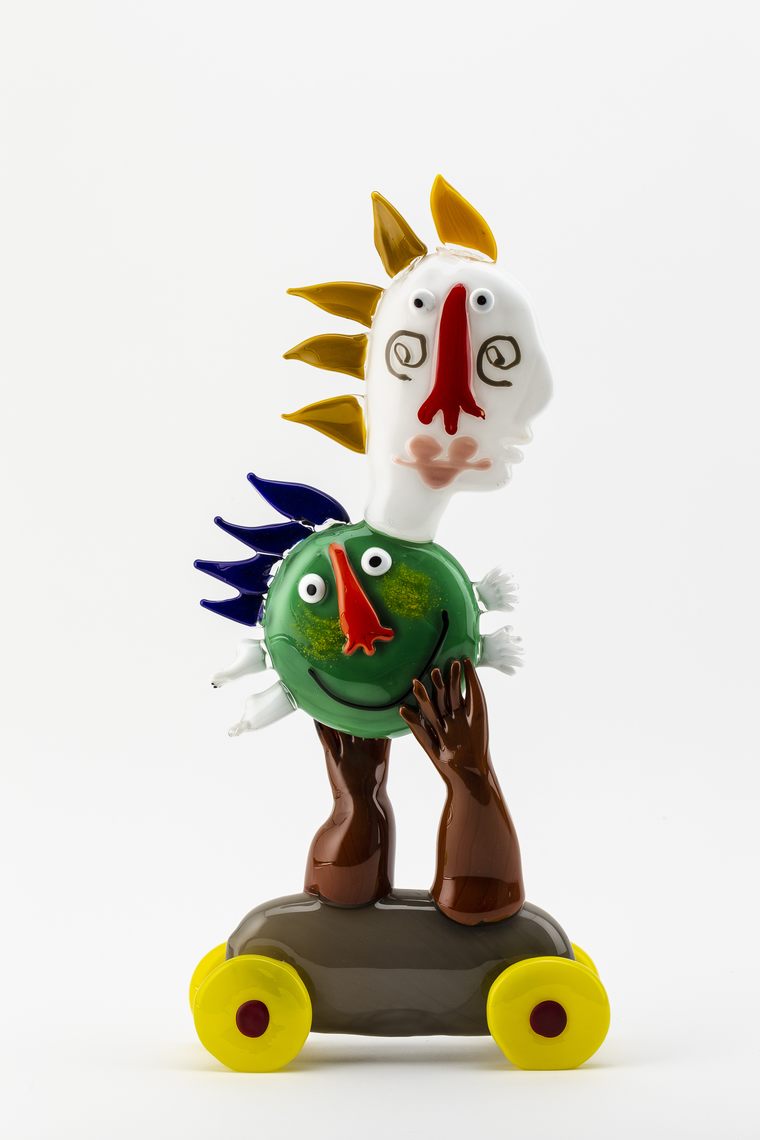Willem de Kooning Untitled XVI 1982 Oil and charcoal on canvas. 80 x 70 in. (203.2 x 177.8 cm). Signed “de Kooning” on the stretcher bar.
Provenance Xavier Fourcade, Inc., New York; Mitchell-Innes & Nash, New York; Private collection, United States Exhibited Paris, Galerie Daniel Templon, Willem de Kooning; Peintures et sculptures récentes, June 14 – July 21, 1984; Düsseldorf, Galerie Hans Strelow, Willem de Kooning Bilder, Skulpturen, Zeichnungen, September 13 – October 20, 1984; New York, L & M Arts, Willem de Kooning 1981-1986, September 11 – November 17, 2007 Literature L & M Arts, ed., Willem de Kooning 1981-1986, New York, 2007, Plate 8, p. 33 (illustrated) Catalogue Essay "Most things in this world are absolutes in terms of taking someone’s word for it. If I made a sphere and asked you, ‘Is it a perfect sphere?’ you would answer, ‘How should I know?’ I could insist that it looks like a perfect sphere. But if you looked at it, after a while you would say, ‘I think it’s a bit flat over here.’ That’s what fascinates me—to make something I can never be sure of, and no one else can either. I will never know, and no one else will ever know. [You believe that’s the way art is?] That’s the way art is." (Willem de Kooning in a 1972 interview with Harold Rosenberg, taken from B. Bürgi, K. Kertess, and R. Ubl, eds, de kooning. Paintings 1960-1980, Basel, 2005, p. 154). The last decade ofWillem de Kooning’s painterly career could have easily been a wash in the wake of his reputation from previous decades; the genesis of this last artistic impulse, in essence a living testament to the artist’s will to create, is at once a stunning model on the power of artistic expression and a story of intense personal struggle. Defying the many odds which were against him at the time, de Kooning nevertheless created, what many believe his finest examples yet or as Robert Storr argues, “of these works, a significant number count among the most remarkable paintings by anyone then active and among the most distinctive, graceful, and mysterious de Kooning himself ever made,” (R. Storr, “At Last Light”, taken from G. Garrels, ed., Willem de Kooning the Late Paintings, the 1980s, San Francisco / Minneapolis, 1995, p. 39). The paintings he created in his ninth decade continued the link from previous years, but there exist a more fluid and open exhibition of color and form within them, the density of the overall chromatic intensity beginning to lighten: “His use of the scraper, which had been a common tool in his work since the 1940s, became pronounced again as he pared back the thickness of surfaces and created ribbon like effects, accelerating the feeling of movement across the canvas,” (ibid, p. 14). Untitled XVI, completed in 1982, originates from this final period of prominence within de Kooning’s master oeuvre, but it is also, significant to many, completed just after the artist fell into a groove with his new, late style, having worked out all the kinks the two years prior to the painting’s completion in 1980 and 1981, and perhaps more poignantly, completed just before the artist’s serious decline in health which ultimately signaled a final break in his artistic output. The years of 1982-1985 are considered by many to be his greatest in overall composition and quality. Many regard this last period of de Kooning’s art to signify a final return to his beginnings. The arabesque curves and careful demarcation of line, all visible in Untitled XVI, give way to larger blocks of primary-based colors, set amongst a field of white. The artist, in the 1960s and 1970s especially, typically exposed little to no white in his canvases, his name justifiably synonymous with washes of vivid hues that erupt on the surfaces of his works. “Nothing like this white had previously been the host of the painting’s plane. Its translucence radiates the light of dreams or reverie more than that of waking experience. De Kooning seems to have been reflecting on his past- the past replete with water and women so that he might turn it into his final beginning,” (K. Kertess, Willem de Kooning NewYork, 2007, p.
Willem de Kooning Untitled XVI 1982 Oil and charcoal on canvas. 80 x 70 in. (203.2 x 177.8 cm). Signed “de Kooning” on the stretcher bar.
Provenance Xavier Fourcade, Inc., New York; Mitchell-Innes & Nash, New York; Private collection, United States Exhibited Paris, Galerie Daniel Templon, Willem de Kooning; Peintures et sculptures récentes, June 14 – July 21, 1984; Düsseldorf, Galerie Hans Strelow, Willem de Kooning Bilder, Skulpturen, Zeichnungen, September 13 – October 20, 1984; New York, L & M Arts, Willem de Kooning 1981-1986, September 11 – November 17, 2007 Literature L & M Arts, ed., Willem de Kooning 1981-1986, New York, 2007, Plate 8, p. 33 (illustrated) Catalogue Essay "Most things in this world are absolutes in terms of taking someone’s word for it. If I made a sphere and asked you, ‘Is it a perfect sphere?’ you would answer, ‘How should I know?’ I could insist that it looks like a perfect sphere. But if you looked at it, after a while you would say, ‘I think it’s a bit flat over here.’ That’s what fascinates me—to make something I can never be sure of, and no one else can either. I will never know, and no one else will ever know. [You believe that’s the way art is?] That’s the way art is." (Willem de Kooning in a 1972 interview with Harold Rosenberg, taken from B. Bürgi, K. Kertess, and R. Ubl, eds, de kooning. Paintings 1960-1980, Basel, 2005, p. 154). The last decade ofWillem de Kooning’s painterly career could have easily been a wash in the wake of his reputation from previous decades; the genesis of this last artistic impulse, in essence a living testament to the artist’s will to create, is at once a stunning model on the power of artistic expression and a story of intense personal struggle. Defying the many odds which were against him at the time, de Kooning nevertheless created, what many believe his finest examples yet or as Robert Storr argues, “of these works, a significant number count among the most remarkable paintings by anyone then active and among the most distinctive, graceful, and mysterious de Kooning himself ever made,” (R. Storr, “At Last Light”, taken from G. Garrels, ed., Willem de Kooning the Late Paintings, the 1980s, San Francisco / Minneapolis, 1995, p. 39). The paintings he created in his ninth decade continued the link from previous years, but there exist a more fluid and open exhibition of color and form within them, the density of the overall chromatic intensity beginning to lighten: “His use of the scraper, which had been a common tool in his work since the 1940s, became pronounced again as he pared back the thickness of surfaces and created ribbon like effects, accelerating the feeling of movement across the canvas,” (ibid, p. 14). Untitled XVI, completed in 1982, originates from this final period of prominence within de Kooning’s master oeuvre, but it is also, significant to many, completed just after the artist fell into a groove with his new, late style, having worked out all the kinks the two years prior to the painting’s completion in 1980 and 1981, and perhaps more poignantly, completed just before the artist’s serious decline in health which ultimately signaled a final break in his artistic output. The years of 1982-1985 are considered by many to be his greatest in overall composition and quality. Many regard this last period of de Kooning’s art to signify a final return to his beginnings. The arabesque curves and careful demarcation of line, all visible in Untitled XVI, give way to larger blocks of primary-based colors, set amongst a field of white. The artist, in the 1960s and 1970s especially, typically exposed little to no white in his canvases, his name justifiably synonymous with washes of vivid hues that erupt on the surfaces of his works. “Nothing like this white had previously been the host of the painting’s plane. Its translucence radiates the light of dreams or reverie more than that of waking experience. De Kooning seems to have been reflecting on his past- the past replete with water and women so that he might turn it into his final beginning,” (K. Kertess, Willem de Kooning NewYork, 2007, p.













.jpg)

Testen Sie LotSearch und seine Premium-Features 7 Tage - ohne Kosten!
Lassen Sie sich automatisch über neue Objekte in kommenden Auktionen benachrichtigen.
Suchauftrag anlegen